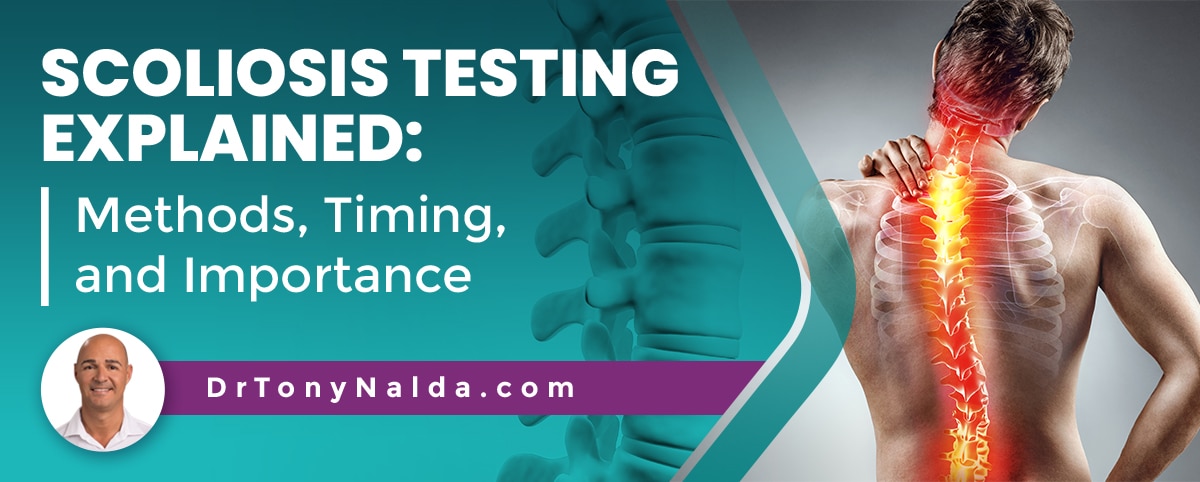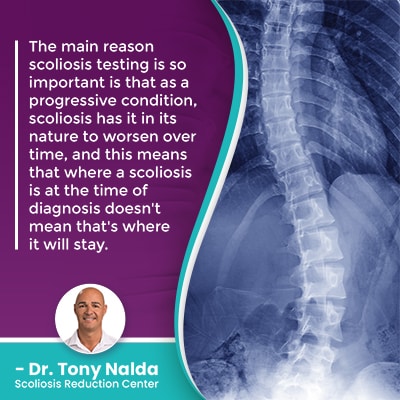Scoliosis Testing Explained: Methods, Timing, and Importance

While there are never treatment guarantees, diagnosing scoliosis early in the condition's progressive line can mean the opportunity to start proactive treatment early, while the condition is mild and most likely to respond favorably. The most common screening exam is known as the Adam's forward bend test.
Scoliosis testing is important because it can lead to early detection, which is associated with treatment success. As a progressive condition, scoliosis is virtually guaranteed to get worse over time, and screening exams like the Adam's forward bend test can help lead to a diagnosis and treatment.
It's not always easy to diagnose scoliosis, especially in children for whom the condition is not yet compressive, and especially when mild, so let's talk about the challenge behind diagnosing scoliosis.
Table of Contents
Diagnosing Scoliosis
With the Scoliosis Research Society putting current estimates at close to seven million people currently living with scoliosis in the United States alone, the condition is highly prevalent; scoliosis is also the leading spinal condition amongst school-aged children, so awareness is definitely needed.
Scoliosis is the development of an unnatural sideways spinal curve, with rotation, and it ranges widely in severity from mild to moderate and severe to very severe.
Scoliosis severity is determined by a measurement known as Cobb angle, and in order to be considered a true scoliosis, the size of the unnatural spinal curve has to have a minimum Cobb angle measurement of at least 10 degrees.
A patient's Cobb angle measurement is an important piece of information that treatment plans are shaped around, and the higher a patient's Cobb angle, the more out of alignment the spine is, and the more severe the condition:
- Mild scoliosis: Cobb angle measurement of between 10 and 25 degrees
- Moderate scoliosis: Cobb angle measurement of between 25 and 40 degrees
- Severe scoliosis: Cobb angle measurement of 40+ degrees
- Very-severe scoliosis: Cobb angle measurement of 80+ degrees
The more severe a condition is, the more noticeable its effects tend to be, but the goal is to diagnose conditions while they are still mild, before they have progressed significantly and become more complex to treat.
So let's talk about what happens when scoliosis progresses.
Understanding Scoliosis Progression
 The main reason scoliosis testing is so important is that as a progressive condition, scoliosis has it in its nature to worsen over time, and this means that where a scoliosis is at the time of diagnosis doesn't mean that's where it will stay.
The main reason scoliosis testing is so important is that as a progressive condition, scoliosis has it in its nature to worsen over time, and this means that where a scoliosis is at the time of diagnosis doesn't mean that's where it will stay.
Scoliosis that's mild when diagnosed can progress to moderate, severe, or very severe, especially if left untreated, or not treated proactively.
In addition to scoliosis ranging so widely in severity, there are also different condition types a person can develop, and in the most prevalent type, we don't understand what triggers its initial onset, and this is idiopathic scoliosis that accounts for approximately 80 percent of known diagnosed cases.
The remaining 20 percent are associated with known causes: neuromuscular scoliosis, degenerative scoliosis, and congenital scoliosis.
Neuromuscular scoliosis is caused by the presence of a larger neuromuscular condition such as cerebral palsy.
Degenerative scoliosis is caused by natural age-related spinal degeneration, and congenital scoliosis is caused by a malformed spine that develops in utero.
Idiopathic scoliosis isn't associated with a single-known cause, but we do know what triggers it to progress: growth and development.
So children diagnosed with scoliosis are more at risk for rapid progression because of the constant trigger of growth.
The most prevalent type of scoliosis overall is adolescent idiopathic scoliosis (AIS), diagnosed between the ages of 10 and 18, and this age group is the most at risk for rapid-phase progression due to adolescent growth spurts, so scoliosis testing is particularly important for effective treatment of adolescent idiopathic scoliosis.
Scoliosis Screenings
There was a time when school screening programs were conducted across the States, but that has since changed, shifting the onus of early detection onto the shoulders of parents and patients themselves.
A scoliosis exam is looking for indicators of the condition that warrant the need for further evaluation and testing.
A typical screening scenario is a parent noticing their adolescent's posture seems to be deviating, and certain asymmetries bring them in for assessment.
The most common type of scoliosis screening exam is known as the Adam's forward bend test, and this is the best means of determining whether or not an X-ray is needed to really see what's happening in and around the spine, and to confirm a patient's Cobb angle and reach an official diagnosis.
A scoliosis exam involves a physical examination during which I observe a patient's posture and how they walk; I can tell a lot about a person's spinal health by their gait.
I also listen to the patient's family/medical history, and then I have the patient stand in front of me and bend forward at the waist, as if trying to touch their toes, with their arms hanging loosely at the sides; in this position, the spine and any postural asymmetries in the trunk are the most visible.
The main condition effect in children is postural deviation, and this can involve uneven shoulders, uneven hips, and the development of a rib cage arch, to name a few.
When paired with a Scoliometer, an Adam's forward bend test can also indicate a patient's angle of trunk rotation (ATR), and the more the spine bends and rotates unnaturally, the more noticeable postural changes are going to be.
So if a scoliosis exam finds condition indicators, I'll order an X-ray to officially confirm the diagnosis, and once a diagnosis is reached, the most important decision patients have to make is how to treat it moving forward.
Scoliosis Treatment Options
If a physical exam and X-ray results have confirmed a diagnosis of adolescent idiopathic scoliosis, it's time to decide on a treatment approach to commit to.
 I want patients to be aware of all treatment options available to them because different types of treatment affect spinal health and function differently, and as a progressive condition, there is no curing scoliosis, but it can be highly treatable, particularly when detected early.
I want patients to be aware of all treatment options available to them because different types of treatment affect spinal health and function differently, and as a progressive condition, there is no curing scoliosis, but it can be highly treatable, particularly when detected early.
If a child is diagnosed in early adolescence with mild scoliosis, this means early detection was achieved because the condition was diagnosed early in its progressive line, and before significant progression has already occurred; this is beneficial because treatment can be started while the curve is still small and simpler to correct, and before the body has had time to adjust to the abnormal spinal curvatures presence.
As scoliosis progresses, the size of the unnatural spinal curvature increases, making it more rigid and less responsive to treatment, and as the condition progresses, its effects also increase, and these can include postural changes and pain (more common in adults).
So it's far more effective to proactively work towards preventing progression than it is to attempt to work towards reversing its effects once established.
Traditional scoliosis treatment tends to funnel patients towards spinal fusion surgery, while conservative treatment focuses on being proactive by starting treatment as close to the time of diagnosis as possible
Conservative Scoliosis Treatment
Here at the Scoliosis Reduction Center, patients benefit from a conservative chiropractic treatment approach because it's less costly, invasive, and preserves as much natural spinal health and function as possible.
By integrating multiple condition-specific treatment disciplines into treatment plans, they can be fully customized and adjusted based on how the spine is responding to growth and treatment.
When treating AIS, the goal is to achieve a significant curvature reduction and hold it there despite the constant trigger of growth.
Chiropractic care is applied in an attempt to manually adjust the position of the scoliotic curve's most-tilted vertebrae, and once I start to see that type of structural result, I can shift the focus to physical therapy and scoliosis-specific exercises capable of increasing core strength so the spine is properly supported and stabilized by its surrounding muscles.
Corrective bracing can be particularly effective on growing spines and can help by pushing the spine into a corrective position, and rehabilitation can involve continued chiropractic care and a series of custom-prescribed home exercises to further stabilize and heal the spine.
Conclusion
The ideal timing for scoliosis screening in children is prior to their first significant pubescent growth spurt because as you now know, it's growth that makes idiopathic scoliosis progress.
While there are never treatment guarantees, diagnosing scoliosis early can mean being able to start treatment early, before the condition starts to progress and becomes more complex to treat.
When it comes to treating scoliosis in adolescents, it's imperative that parents and patients understand that the best time to start treatment is always now, and the best time to start screening for scoliosis is before puberty starts.
In early-onset juvenile scoliosis, diagnosed between the ages of 3 and 10, this is when I can make the biggest impact with treatment because the condition was caught prior to the start of puberty.
When it comes to early detection and screening, it's beneficial for parents and/or caregivers to have awareness of the condition's subtle early signs to watch out for, including changes to balance, gait, coordination, and postural asymmetries.
Dr. Tony Nalda
DOCTOR OF CHIROPRACTIC
After receiving an undergraduate degree in psychology and his Doctorate of Chiropractic from Life University, Dr. Nalda settled in Celebration, Florida and proceeded to build one of Central Florida’s most successful chiropractic clinics.
His experience with patients suffering from scoliosis, and the confusion and frustration they faced, led him to seek a specialty in scoliosis care. In 2006 he completed his Intensive Care Certification from CLEAR Institute, a leading scoliosis educational and certification center.
About Dr. Tony Nalda
 Ready to explore scoliosis treatment? Contact Us Now
Ready to explore scoliosis treatment? Contact Us Now





